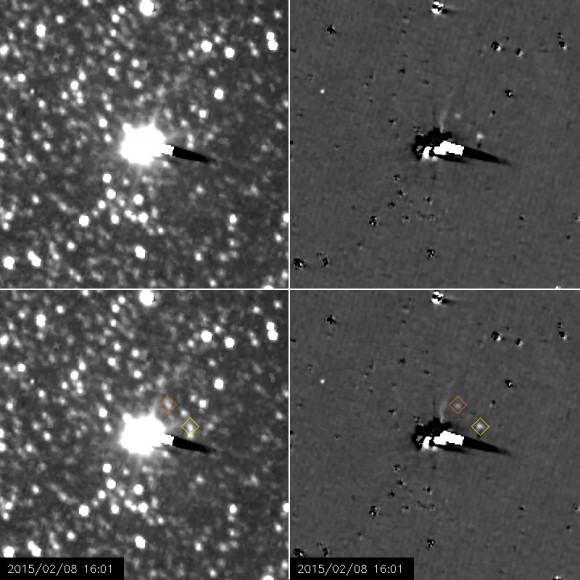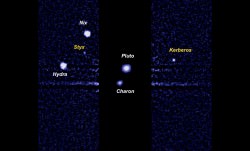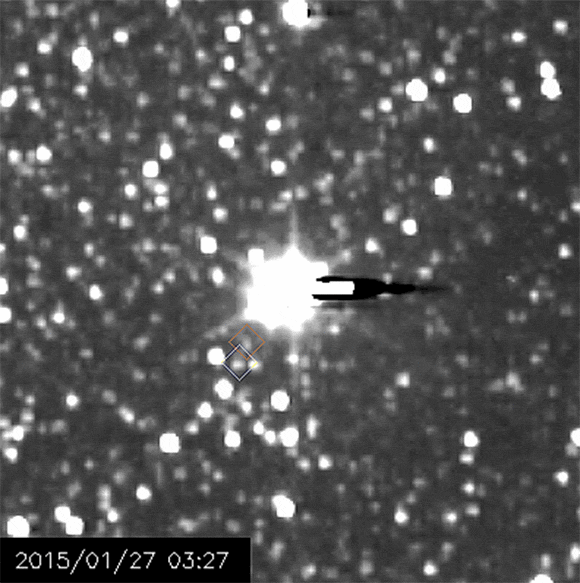Now on the final leg of its journey to distant Pluto the New Horizons spacecraft has been able to spot not only the dwarf planet and its largest moon Charon, but also two of its much smaller moons, Hydra and Nix – the latter for the very first time!
The animation above comprises seven frames made of images acquired by New Horizons from Jan. 27 to Feb. 8, 2015 while the spacecraft was closing in on 115 million miles (186 million km) from Pluto. Hydra is noted by a yellow box and Nix is in the orange. (See a version of the animation with some of the background stars and noise cleared out here.)
What’s more, these images have been released on the 85th anniversary of the first spotting of Pluto by Clyde Tombaugh at the Lowell Observatory in Flagstaff, AZ.
“Professor Tombaugh’s discovery of Pluto was far ahead its time, heralding the discovery of the Kuiper Belt and a new class of planet. The New Horizons team salutes his historic accomplishment.”
– Alan Stern, New Horizons PI, Southwest Research Institute
Launched Jan. 19, 2006, New Horizons will make its closest pass of Pluto and Charon on July 14 of this year. It is currently 32.39 AU from Earth – over 4.84 billion kilometers away.
“It’s thrilling to watch the details of the Pluto system emerge as we close the distance to the spacecraft’s July 14 encounter,” said New Horizons science team member John Spencer from the Southwest Research Institute (SwRI). “This first good view of Nix and Hydra marks another major milestone, and a perfect way to celebrate the anniversary of Pluto’s discovery.”
Along with the distance between Earth and Pluto, New Horizons is also bridging the gap of history: a portion of Mr. Tombaugh’s ashes are being carried aboard the spacecraft, as well as several historic mementos.

Each frame in the animation is a combination of five 10-second images taken with New Horizons’ Long-Range Reconnaissance Imager (LORRI) using a special mode that increases sensitivity at the expense of resolution. Celestial north is inclined 28 degrees clockwise from the “up” direction in these images.
The dark streaks are a result of overexposure on the digital camera’s sensitive detector.

Pluto has a total of five known moons: Charon, Hydra, Nix, Styx, and Kerberos. Pluto and Charon are within the glare of the image exposures and can’t be resolved separately, and Styx and Kerberos are too dim to be detected yet. But Hydra and Nix, each around 25–95 miles (40–150 km) in diameter, could be captured on camera.
More precise measurements of these moons’ sizes – and whether or not there may be even more satellites in the Pluto system – will be determined as New Horizons approaches its July flyby date.
Learn more about the New Horizons mission here.
Source: NASA


This is exciting! What about the other objects moving through the frame to the left? There are 2 or 3 different objects. One clearly moved through 3 successive frames heading near 6-7 o’clock.
This. http://i1.kym-cdn.com/photos/images/newsfeed/000/158/326/9148130.jpg
brentbert and Jason, I find that object very interesting. It’s moving too fast to be a star, we know of no other planets or moons to show up there like that, and if it’s a moon of Pluto we know nothing about yet, it sure is moving on a very elongated path, since it’s going almost straight from up to down in the animation and not in a circle (ellipse) around Pluto. It’s much easier to spot it in the animation than on the photos, especially on the right side with the stars removed.
If anyone has an educated idea about what it might be, I’d be interested to know.